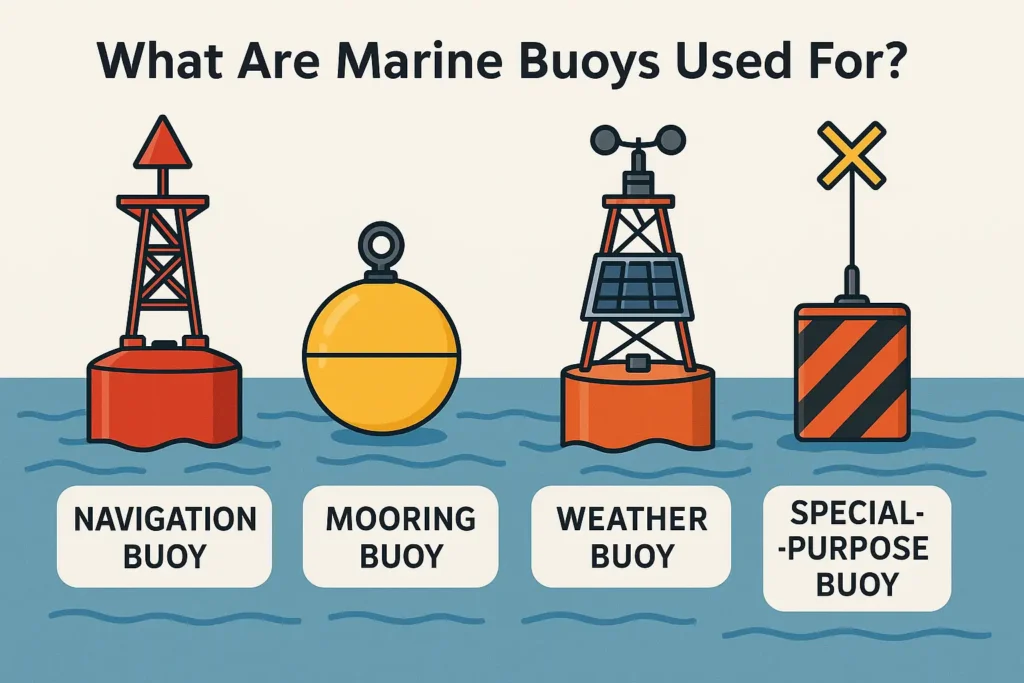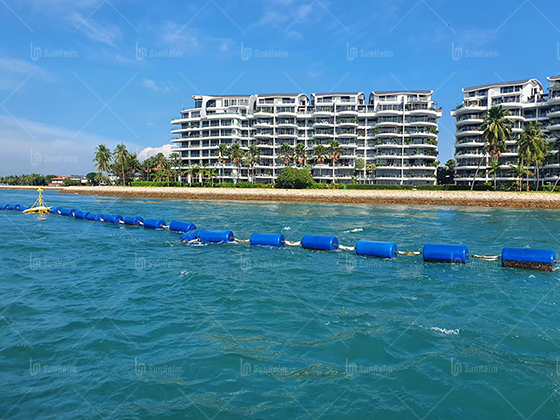Introduction: Why Marine Buoys Matter
Marine buoys play a critical role in ensuring safe navigation, scientific observation, and environmental monitoring. Whether you’re piloting a vessel or managing offshore projects, understanding the types and uses of marine buoys can significantly enhance safety and efficiency at sea.
At Sunhelm, we specialize in durable, intelligent buoy systems that meet modern marine demands. This guide explores the many ways marine buoys serve industries and oceans alike.

What Are Marine Buoys?
Marine buoys are floating devices anchored in position to mark specific locations, relay data, or assist with navigation. Their core functions include:
- Guiding maritime traffic
- Warning of underwater hazards
- Supporting mooring operations
- Collecting weather and oceanographic data
- Marking fishing gear or diving zones

Main Uses of Marine Buoy
1. Navigation and Channel Marking
Navigation buoys are essential for vessel guidance and hazard avoidance. The most common types include:
- Lateral Buoys: Mark port (red) and starboard (green) sides of channels.
- Cardinal Buoys: Indicate the direction of safe water (north, south, east, west).
- Safe-Water Buoys: Show safe, navigable waters all around (red-and-white vertical stripes).
- Isolated Danger Buoys: Mark isolated hazards like rocks or wrecks.
These buoys follow IALA buoyage systems, standardizing colors, shapes, and light patterns for global consistency.
2. Mooring and Anchoring Support
Mooring buoys allow boats to tie up without dropping an anchor. They’re widely used in:
- Harbors and marinas
- Coral reef protection zones
- Aquaculture facilities
By reducing anchor drag, mooring buoys protect seabeds and improve space utilization.
3. Weather and Ocean Monitoring
Scientific marine buoys gather real-time environmental data. Sunhelm offers advanced systems for:
- Weather Buoys: Measure wind speed, temperature, humidity, and barometric pressure
- Wave Buoys: Track wave height, direction, and period
- Metocean Buoys: Combine meteorological and oceanographic data for offshore energy or coastal development
These data buoys support weather forecasting, tsunami alerts, and climate research.
4. Hazard & Special Area Marking
Special-purpose buoys are used to mark:
- Racecourse routes for sailing competitions
- Shipwrecks or submerged obstructions
- Military testing zones or underwater cables
- Diving areas using Surface Marker Buoys (SMBs)
They are often color-coded and equipped with unique light sequences.
5. Fishing and Aquaculture Use
In the commercial fishing industry, lobster trap buoys and net marker floats help identify gear locations. Bright colors and flags improve visibility in crowded waters.
6. Smart Marine Buoy Systems (IoT Buoys)
Modern marine buoys are becoming “smart” with technologies such as:
- GPS tracking
- Satellite or LoRa communication
- Solar-powered sensors
- Real-time environmental alerts
Sunhelm’s smart buoy systems can integrate with centralized platforms for predictive analytics, asset tracking, and remote diagnostics.
Why Choose Sunhelm?
At Sunhelm, we engineer marine buoys with:
- Durable construction: UV-resistant, marine-grade HDPE or foam-filled shells
- Custom configurations: Tailored for navigation, mooring, or scientific use
- Reliable power: Solar modules with lithium backup systems
- Global compliance: IALA, IMO, and NOAA standards
Whether your needs are commercial, scientific, or governmental, we deliver buoy solutions that stand the test of time.
Future Trends in Marine Buoys
The marine industry is rapidly adopting:
- IoT integration for real-time monitoring
- Eco-friendly materials to reduce ocean waste
- Modular buoy designs for easier maintenance
- Cloud-based buoy fleet management
As oceans become busier and environmental challenges rise, marine buoys will remain at the heart of maritime innovation.
FAQs – People Also Ask
Q1: What are marine buoys made of?
High-density polyethylene (HDPE), polyurethane foam, or composite materials for durability and buoyancy.
Q2: How are buoys powered?
Most use solar panels with battery backup, especially for lighted or smart buoys.
Q3: Are marine buoy regulated?
Yes. Organizations like IALA and NOAA define international buoy standards.
Q4: How do I choose the right buoy type?
It depends on the application—navigation, mooring, weather monitoring, etc. Sunhelm offers consultation for custom needs.
Conclusion
Marine buoys are much more than floating markers—they’re essential tools for navigation, safety, environmental monitoring, and more. From guiding ships to collecting climate data, they serve as the eyes and ears of the ocean.
Sunhelm is proud to support global marine operations with expertly designed, durable, and smart buoy systems. Ready to upgrade your marine buoy setup? Contact us today for a custom quote.


